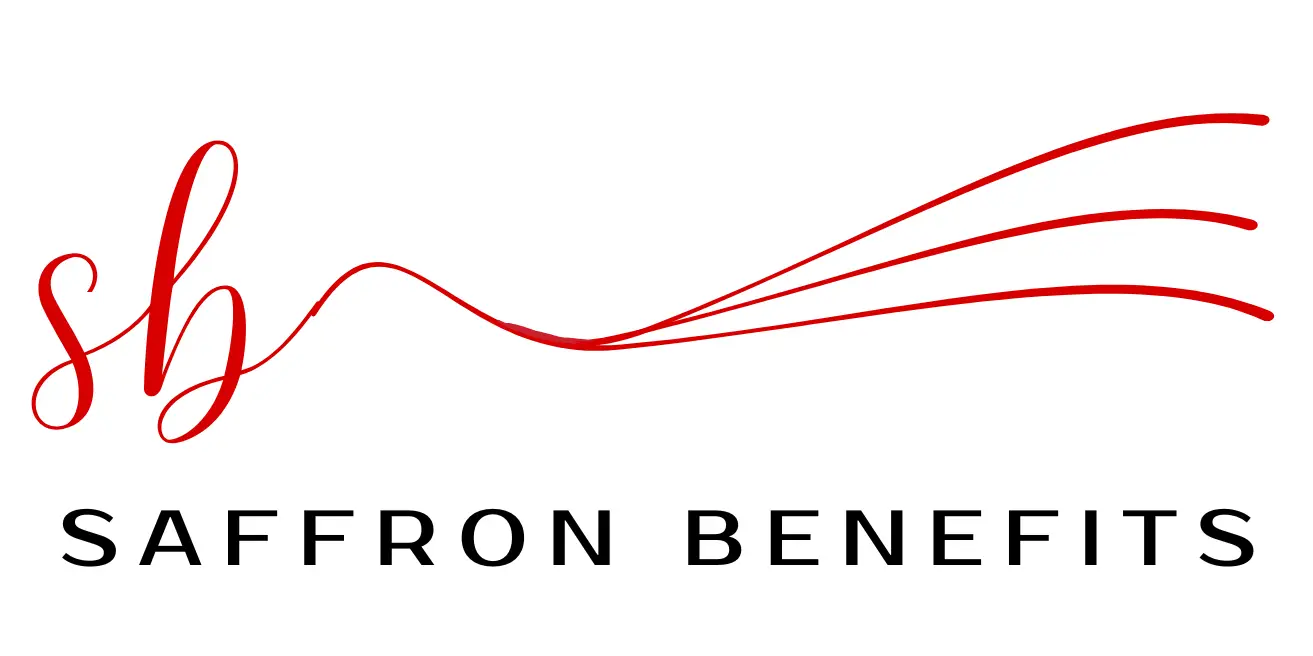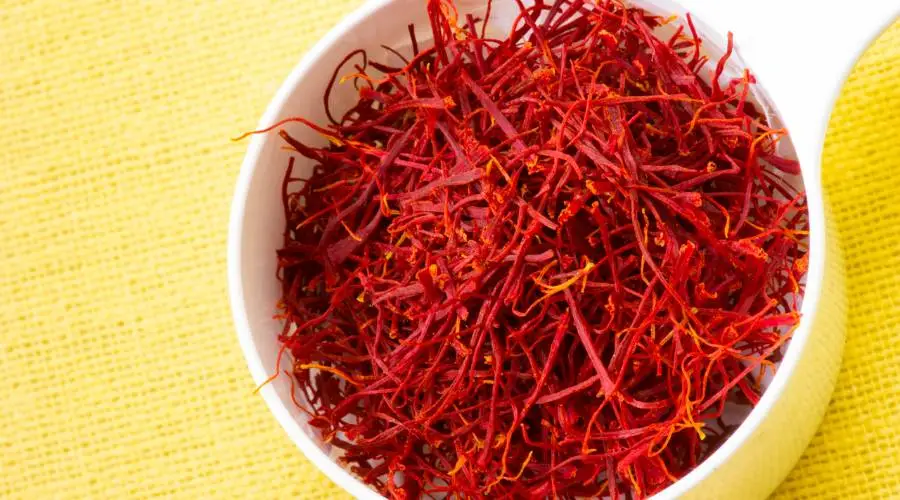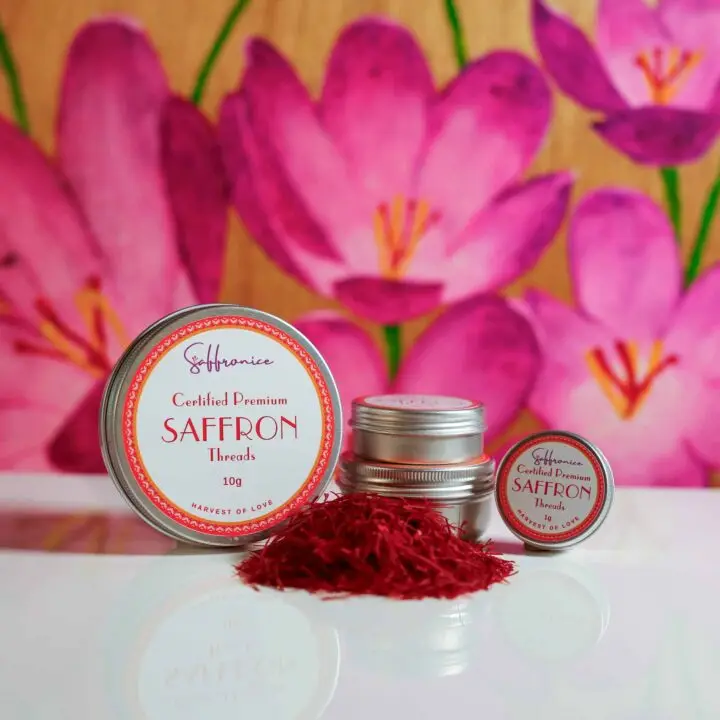📌 Quick Answer: Real saffron has deep red threads with orange tips, trumpet-shaped ends, a honey-hay aroma, and releases golden color slowly in water. Fake saffron shows uniform color, lacks a distinctive scent, dissolves quickly, and often contains synthetic dyes or plant substitutes like corn silk or safflower petals.
Saffron, often called the “golden spice,” is famous for its ability to add wonderful aroma, rich taste, and vibrant color to many dishes. Whether it’s Mediterranean favorites like paella and risotto or Middle Eastern delights such as biryani and baklava, authentic saffron is an essential ingredient in various cooking traditions.
When it comes to cooking, knowing how to tell real saffron from fake saffron is very important. The quality of your dishes depends on using genuine saffron, which also ensures you get all its remarkable health benefits. Although it can be difficult to differentiate between authentic saffron and imitations, doing so is crucial for preserving the authenticity of your culinary creations.
Chef’s Professional Tip: After years in professional kitchens, I’ve learned that authentic saffron is an investment that transforms dishes completely. The difference between real and fake saffron isn’t just about flavor—it’s about culinary integrity and the heritage of this ancient spice.
Understanding Saffron: The Foundation of Authenticity
Origin and Harvesting Process of Saffron
Saffron comes from the flower Crocus sativus and has its fascinating historical roots in ancient Persia. This delicate plant thrives in specific climates, particularly in countries like Iran, Spain, and India. Saffron cultivation is no easy task; it requires intensive hand labor and careful picking to maintain the purity and quality of each thread.
Each flower only produces three stigmas, which are plucked at dawn when the flowers are fully open. After being harvested, these stigmas are dried to create the saffron threads we cherish. This labor-intensive process explains why genuine saffron commands premium prices and why counterfeiting has become so prevalent.
Food Scientist’s Note: The bioactive compounds that give saffron its therapeutic properties—crocin, safranal, and picrocrocin—are only present in genuine Crocus sativus stigmas. Fake substitutes lack these valuable compounds entirely.
Unique Characteristics That Define Genuine Saffron Threads
Understanding saffron quality standards helps identify authentic products. Genuine saffron threads possess several unique characteristics:
- Color: Real saffron threads exhibit a deep red hue with slight orange tips, reflecting natural variation in crocin content
- Shape: Authentic saffron threads have a distinctive trumpet-like shape with flared ends, tapering to fine points
- Texture: The texture of real saffron is dry and brittle to the touch, indicating proper drying and storage
- Aroma: Genuine saffron exudes a complex aroma reminiscent of honey and hay with subtle metallic notes
These distinct features enable culinary enthusiasts to appreciate the authenticity and luxury of true saffron in their dishes.
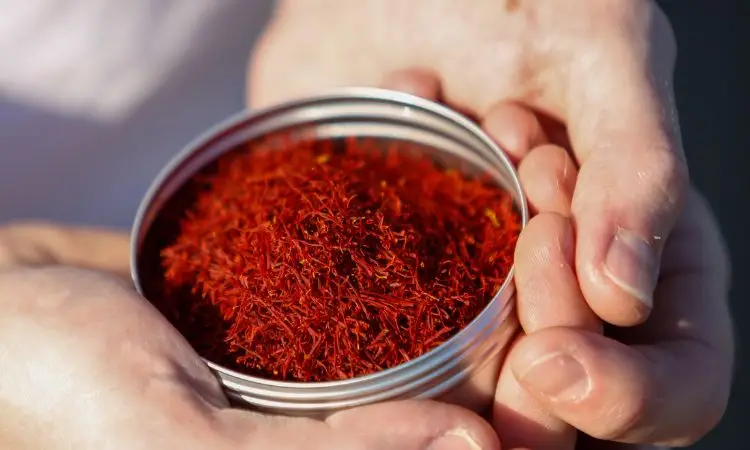
International Saffron Classification Systems
Professional saffron grading systems provide standardized methods for evaluating quality:
ISO 3632 International Standards
- Category I (Superior): Crocin content >250, minimal foreign matter
- Category II (Good): Crocin content 190-250, moderate quality
- Category III (Standard): Crocin content 150-190, basic quality
Spanish Grading Classifications
- Coupe: Highest grade with only red stigma tips
- Mancha: Standard grade with some yellow/orange portions
- Rio: Lower grade with more stem material
Understanding these classifications helps consumers make informed purchasing decisions and avoid substandard products marketed as premium saffron.
Recognizing Fake Saffron: Know Your Enemy
The appeal of saffron’s golden color and intoxicating aroma has led to a sophisticated black market filled with counterfeit products. Dishonest sellers use various materials to create imitation saffron, attempting to replicate this valuable spice while charging similar prices.
Common Materials Used in Producing Fake Saffron
Plant-Based Substitutes:
- Dyed corn silk: Fine corn strands soaked in artificial colorants to resemble saffron threads
- Maize or coconut tassels: Fibrous plant parts cut and tinted, then sold as “saffron”
- Safflower petals: Visually similar orange-red petals that lack distinctive flavor and aroma
- Turmeric-dyed materials: Various plant fibers colored with turmeric for a golden appearance
Non-Plant Adulterants:
- Red-dyed horsehair: Animal hair treated with food coloring to mimic thread appearance
- Shredded paper or plastic: Used to bulk up packages and increase weight
- Old saffron threads: Previously used saffron re-dyed and resold as fresh
Key Characteristics Indicating Counterfeit Saffron
Visual Red Flags:
- Uniform Color: Real saffron displays natural variations from deep red tips to yellowish bases. Imitations often show flat, unnatural red coloration throughout
- Texture and Shape: Genuine saffron threads are trumpet-shaped at one end and slightly frayed at the other. Fakes may appear stiff, uniformly cut, or lack this iconic silhouette
- Thread Consistency: Authentic saffron shows natural variation in thread size and shape, while counterfeits often appear machine-cut and identical
Sensory Warning Signs:
- Scent: Authentic saffron emits a complex fragrance—honeyed, earthy, subtly metallic. Counterfeits typically smell musty, chemical-laden, or have no scent at all
- Taste: Instead of the bittersweet warmth real saffron imparts, fake saffron tastes bland, bitter, or artificially sweet
Comprehensive Testing for Authenticity
Ensuring your saffron is genuine involves systematic testing methods. These proven purity testing techniques help distinguish real saffron from counterfeits, ensuring you achieve the desired flavor and color in culinary creations.
Advanced Visual Inspection Methods
Microscopic Examination: Professional evaluation reveals a cellular structure unique to Crocus sativus stigmas. Authentic saffron shows characteristic cellular patterns and oil gland distribution that counterfeits cannot replicate.
Thread Structure Analysis:
- Authentic threads: Show natural tapering with trumpet-shaped tips and slight curves
- Fake threads: Often appear too uniform, straight, or mechanically cut
- Color distribution: Real saffron exhibits gradient coloring from deep red to lighter orange-yellow
Laboratory-Style Home Tests
Enhanced Water Test Protocol:
- Place 2-3 threads in 60ml warm water (not boiling)
- Observe color release pattern—authentic saffron releases golden-yellow color gradually over 10-15 minutes
- Check thread integrity—genuine threads maintain structure while fake ones may disintegrate
- Critical indicator: Real saffron water maintains a clear golden color; fake saffron often produces a murky, artificially bright liquid
Advanced Smell Test Technique: Crush threads between clean fingers and evaluate aroma complexity:
- Authentic saffron: Multi-layered scent with honey, hay, and subtle metallic notes
- Counterfeit products: Single-note smells, chemical odors, or no fragrance
Professional Taste Evaluation: Place a small amount on the tongue tip:
- Real saffron: Initial slight bitterness followed by subtle sweetness and warmth
- Fake saffron: Bland, overly sweet, or harsh chemical taste
The Serious Dangers of Using Fake Saffron
Health Risks and Adulteration Concerns
Counterfeit saffron poses significant health risks due to harmful adulterants and synthetic additives. Unlike genuine saffron’s health benefits, fake products can cause:
Immediate Health Risks:
- Allergic reactions: Synthetic colorants trigger skin irritations and respiratory problems
- Toxic exposure: Heavy metals and industrial dyes cause food poisoning symptoms
- Chemical sensitivity: Artificial preservatives and additives lead to digestive issues
Long-term Health Consequences:
- Nutritional deficiency: Missing antioxidants, vitamins, and beneficial compounds found in authentic saffron
- Compromised immune function: Exposure to contaminants weakens natural defenses
- Unknown chemical exposure: Unregulated substances with unpredictable health effects
Understanding potential side effects helps consumers make informed decisions about saffron safety and authenticity.
Economic and Industry Impact
The illegal trade of fake saffron creates devastating consequences:
Market Disruption:
- Genuine producers face financial losses from unfair price competition
- Consumer trust erodes, affecting legitimate businesses
- The quality reputation of authentic saffron becomes compromised
Supply Chain Integrity:
- Counterfeit products flood markets, making authentic saffron harder to find
- Certification processes become more complex and expensive
- Traditional farming communities suffer economic hardship
Expert Guidelines for Purchasing Genuine Saffron
Understanding Price as a Quality Indicator
Saffron is one of the world’s most expensive spices, and its high price reflects the labor-intensive harvesting process. It takes approximately 150 flowers to produce just one gram of saffron. If you encounter saffron sold at prices significantly below market averages, exercise extreme caution.
Price Benchmarks (2024):
- Premium Grade A: $3,000-$5,000 per kilogram ($15-25 per gram)
- Standard Grade B: $2,000-$3,000 per kilogram ($10-15 per gram)
- Commercial Grade: $1,500-$2,000 per kilogram ($8-12 per gram)
Any saffron priced substantially below these ranges likely indicates adulteration or counterfeiting.
Navigating the Challenge of Ground Saffron Verification
Ground saffron presents unique authenticity challenges. The powdered form becomes vulnerable to adulteration with substances like turmeric, paprika, or dyed corn silk that imitate saffron’s vibrant colors.
Verification Strategies for Ground Saffron:
- Laboratory certificates: Request third-party testing documentation from reputable sellers
- Origin information: Premium brands provide detailed source information and batch numbers
- Microscopic analysis: Professional evaluation reveals a cellular structure unique to genuine saffron
For maximum authenticity assurance, choose threads over powder whenever possible. The characteristic trumpet-shaped tips and natural color variations are extremely difficult to replicate convincingly.
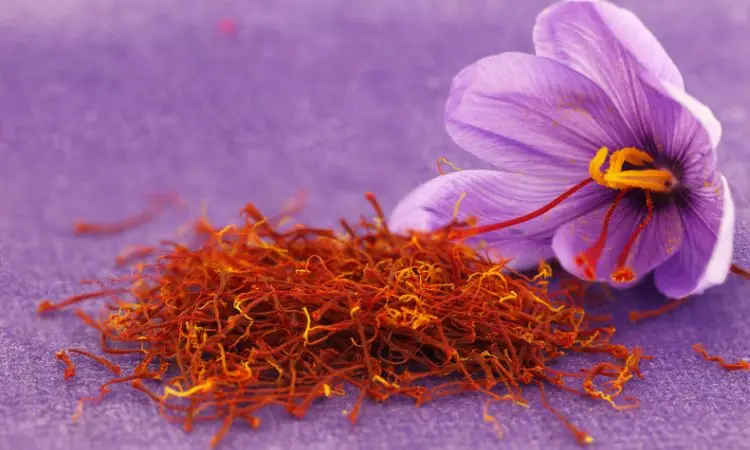
Building a Reliable Saffron Supply Chain
Selecting Reputable Suppliers
The journey from crocus flower to your kitchen requires careful supplier selection. Trusted vendors provide transparency regarding origin, harvest dates, and handling methods. Look for suppliers who offer:
Documentation Standards:
- Certificates of authenticity from recognized testing laboratories
- Detailed origin information, including specific growing regions
- Batch tracking numbers for quality control
- ISO 3632 compliance certification
Quality Assurance Practices:
- Regular third-party testing for purity and potency
- Proper storage and handling protocols
- Clear return policies for unsatisfactory products
- Customer reviews and testimonials from verified purchases
When researching where to buy saffron online, prioritize vendors with established reputations and transparent business practices.
Comparing Premium Brands and Sources
Understanding saffron brand differences helps consumers make informed choices. Reputable brands invest in quality control, proper sourcing, and consumer education.
Evaluation Criteria:
- Source country and growing region reputation
- Processing and packaging methods
- Testing protocols and quality certifications
- Customer service and authenticity guarantees
Consider the differences between premium and regular saffron when selecting products for specific culinary applications.
Proper Storage and Handling for Authenticity Preservation
Maintaining saffron’s integrity after purchase requires meticulous storage practices. Proper handling preserves the essential oils responsible for saffron’s distinctive aroma and color while preventing degradation that might create doubt about authenticity.
Optimal Storage Conditions
Environmental Requirements:
- Temperature: Cool, stable temperatures between 35-40°F (2-4°C)
- Humidity: Less than 10% relative humidity to prevent mold growth
- Light exposure: Complete darkness to preserve photosensitive compounds
- Air circulation: Minimal exposure to prevent oxidation
Container Selection:
- Glass containers: Non-reactive materials that don’t absorb aromas
- Airtight sealing: Prevents moisture infiltration and aroma loss
- Size appropriate: Minimal air space to reduce oxidation
- Opaque materials: Block harmful light exposure
Critical Storage Tips: Never store saffron near strong spices or in plastic containers—aromas may mingle and compromise purity, potentially creating confusion about authenticity. Avoid refrigerator storage unless properly sealed, as temperature fluctuations and moisture can degrade quality.
Culinary Applications: Maximizing Authentic Saffron’s Potential
Understanding how to cook with saffron properly ensures you get maximum value from authentic threads. Proper preparation techniques release the full flavor profile and vibrant color that make saffron so prized in global cuisines.
Preparation Methods:
- Bloom technique: Steep threads in warm liquid for 10-15 minutes before use
- Grinding method: Crush threads with sugar or salt for even distribution
- Direct infusion: Add threads directly to hot liquids during cooking
Culinary Pairings: Authentic saffron complements rice dishes, seafood preparations, dairy-based desserts, and traditional bread recipes. The complex flavor profile of genuine saffron cannot be replicated by substitutes or counterfeits.
Conclusion: Protecting Your Investment in Authentic Saffron
Ensuring saffron authenticity is crucial for both culinary excellence and health safety. By understanding the differences between real and fake saffron, you can protect your dishes’ integrity and avoid potential health risks associated with counterfeit products.
Essential Authenticity Checklist:
- Visual inspection: Deep red threads with orange tips and trumpet shapes
- Aroma evaluation: Complex honey-hay fragrance with subtle metallic notes
- Water test: Slow golden color release with maintained thread integrity
- Price verification: Realistic pricing that reflects harvesting costs
- Supplier validation: Reputable sources with quality certifications
Key Takeaways:
- Authentic saffron exhibits distinctive physical and sensory characteristics
- Systematic testing methods reliably identify genuine products
- Reputable suppliers provide transparency and quality assurance
- Proper storage preserves authenticity and prevents degradation
- Investment in real saffron ensures culinary success and health benefits
By applying these professional guidelines, you can confidently select genuine saffron that will elevate your culinary creations while providing the full spectrum of benefits this remarkable spice offers. The extra effort invested in authentication pays dividends in both flavor and peace of mind.
FAQs (Frequently Asked Questions)
What are the most reliable tests to identify authentic saffron at home?
The most reliable home tests include the water test (genuine saffron releases golden color slowly), aroma evaluation (authentic saffron has a complex honey-hay fragrance), and visual inspection (real threads show trumpet shapes with red-to-orange color gradation). Combining multiple tests provides the highest accuracy.
Why is authentic saffron so much more expensive than imitations?
Authentic saffron requires hand-harvesting of individual stigmas from Crocus sativus flowers, with each flower producing only three threads. It takes approximately 150 flowers to produce one gram of saffron, making it one of the world’s most labor-intensive spices and justifying premium pricing.
What health risks are associated with consuming fake saffron?
Fake saffron may contain harmful synthetic dyes, heavy metals, and chemical adulterants that can cause allergic reactions, digestive problems, and toxic exposure. Unlike authentic saffron, which offers health benefits, counterfeits provide no nutritional value and pose unknown health risks.
How can I find reputable suppliers for authentic saffron?
Look for suppliers offering laboratory certificates, detailed origin information, ISO 3632 compliance, and transparent quality assurance practices. Reputable vendors provide batch tracking, customer testimonials, and clear return policies while maintaining realistic pricing that reflects genuine saffron’s production costs.
What’s the difference between ground saffron and whole threads in terms of authenticity?
Whole threads are much easier to authenticate due to their distinctive trumpet shape, natural color variation, and structural integrity. Ground saffron is more vulnerable to adulteration with turmeric, paprika, or other substances, making verification challenging without laboratory analysis.
How should I store saffron to maintain its authenticity and quality?
Store saffron in airtight glass containers in cool, dark, dry conditions away from strong aromas. Avoid plastic containers and temperature fluctuations. Proper storage preserves the essential oils and compounds that distinguish authentic saffron while preventing degradation that could create quality concerns.
